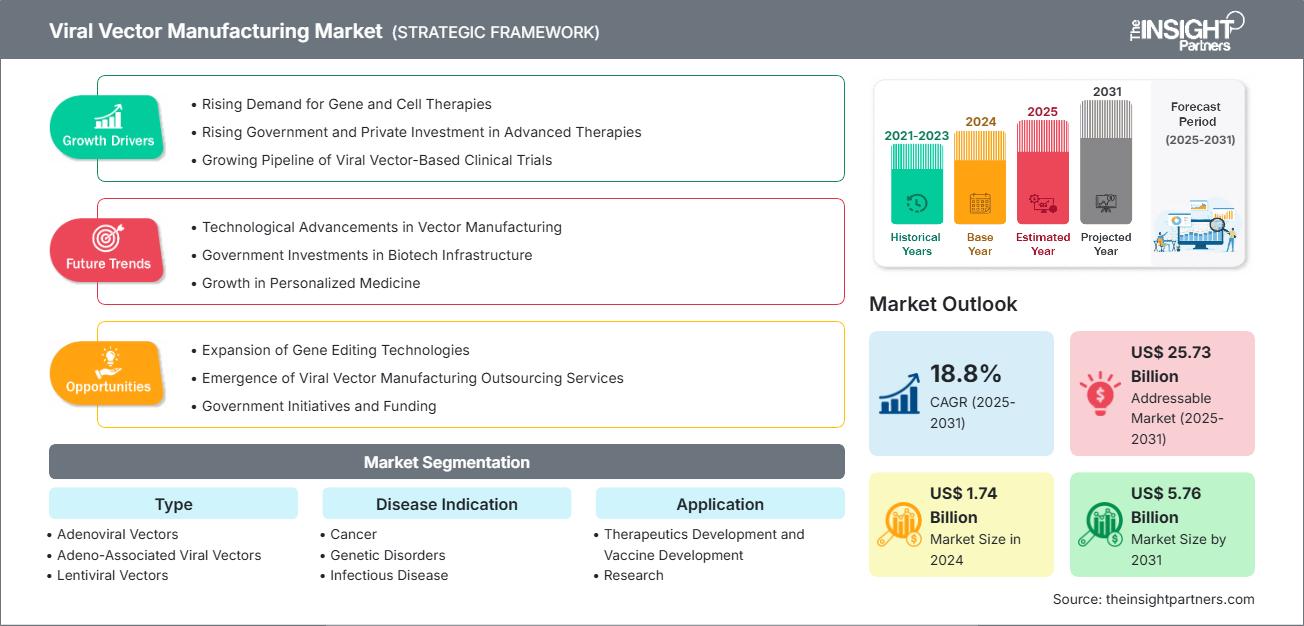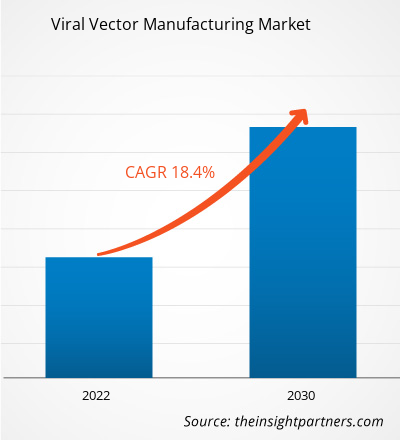预计到2031年,病毒载体生产市场规模将从2024年的17.4亿美元达到57.6亿美元。预计该市场在2025年至2031年期间的复合年增长率将达到18.8%。
病毒载体生产市场分析
受基因疗法和疫苗需求不断增长的推动,病毒载体生产市场正经历快速扩张。主要趋势包括技术进步、投资增加和战略合作。挑战包括生产成本高、规模化生产困难以及严格的监管要求。
病毒载体生产市场概览
病毒载体是经过基因工程改造的病毒,用于在基因和细胞疗法、疫苗和研究中递送遗传物质。其生产过程包括设计、细胞培养、纯化、质量控制以及符合GMP规范的制剂配制,以确保安全性、效力和稳定性。
您可以免费获得任何报告的定制服务,包括本报告的部分内容、国家/地区层面的分析、Excel 数据包,以及面向初创企业和高校的优惠折扣。
病毒载体生产市场:战略洞察

-
获取本报告的主要市场趋势。这份免费样品将包含数据分析,内容涵盖市场趋势、估算和预测等。
病毒载体生产市场驱动因素和机遇
市场驱动因素:
- 基因和细胞疗法研发管线不断增长:基因疗法、细胞疗法和先进治疗方案的普及增加了对 GMP 级病毒载体(AAV、慢病毒等)的需求。
- 生物制造基础设施的投资与融资:政府、风险投资和生物制药公司正在为设施扩建、技术升级和 CDMO 规模扩大提供资金。
- 技术创新:使用一次性生物反应器、封闭系统、在线分析和模块化平台有助于降低污染风险并提高产量/通量。
- 外包给CDMO/专业服务提供商:许多生物技术和制药企业倾向于将载体生产外包,而不是建立内部产能。这一趋势促进了CDMO的发展。
- 先进疗法的监管支持与简化:一些监管机构正在为基因疗法和病毒载体产品引入更清晰的指导方针,以减少不确定性。
市场机遇:
- 拓展基因治疗和疫苗开发:随着基因疗法和病毒载体疫苗研发管线的不断增加,对专业化生产的需求预计将会上升,从而为开发定制化和可扩展的载体生产带来机遇。
- 罕见遗传疾病和癌症的需求不断增长:随着针对罕见疾病和癌症的基因疗法获得批准和临床试验的数量不断增加,对高质量病毒载体的需求也在上升,扩大了生产要求,并推动了各个治疗领域的市场增长。
- 制造技术的进步:制造技术的进步,包括一次性生物反应器和连续加工,最大限度地提高了每批次的产量,并最大限度地降低了污染风险和制造成本。
- 可定制和可扩展的制造方案:规模化和增长,使其对初创企业和大型制药公司都具有吸引力,从而改善全球市场扩张。
病毒载体生产市场报告细分分析
为了解病毒载体生产市场的结构、增长前景和新兴趋势,可将其划分为不同的细分市场。以下是行业报告中常用的标准细分方法:
按类型:
- 腺病毒载体:非整合型载体,可递送大型基因;引起强烈的免疫反应;用于基因治疗和疫苗。
- 腺相关病毒载体:它无致病性,能够进行位点特异性整合,提供长期基因表达且免疫原性低,是基因治疗中治疗非分裂细胞的理想选择。
- 慢病毒载体:它们能有效整合到分裂细胞和非分裂细胞的基因组中,实现稳定、长期的基因表达,常用于研究和临床基因治疗应用。
- 逆转录病毒载体:它们只能整合到分裂细胞的基因组中,从而实现稳定的基因转移,但靶向范围有限,并且存在潜在的插入突变风险。
- 其他:其他病毒载体,如疱疹病毒和牛痘病毒,具有独特的组织靶向性和更大的基因有效载荷能力,适用于专门的基因治疗和疫苗策略。
按技术分类:
- 癌症:病毒载体可诱导靶向治疗和免疫疗法,用于治疗多种癌症。这种方法有望带来更具针对性的治疗方案和更好的患者预后。
- 遗传疾病:病毒载体用于递送基因治疗方法,以纠正缺陷基因并有效治疗遗传性疾病。
- 传染病:病毒载体被用于疫苗开发和治疗药物输送,以应对艾滋病毒、COVID-19 和肝炎等传染病。
- 其他:包括神经系统疾病、心血管疾病和罕见病等适应症,病毒载体将有助于基因传递和治疗干预。
按申请方式:
- 治疗药物开发
- 疫苗研发
- 研究
最终用户:
- 制药和生物技术公司
- CDMO 和 CRO
- 研究机构
按地理位置:
- 北美
- 欧洲
- 亚太地区
- 南美洲和中美洲
- 中东和非洲
病毒载体生产市场区域洞察
The Insight Partners 的分析师对预测期内影响病毒载体生产市场的区域趋势和因素进行了详尽的阐述。本节还探讨了北美、欧洲、亚太、中东和非洲以及南美和中美洲等地区的病毒载体生产市场细分和地域分布情况。
病毒载体生产市场报告范围
| 报告属性 | 细节 |
|---|---|
| 2024年市场规模 | 17.4亿美元 |
| 到2031年市场规模 | 57.6亿美元 |
| 全球复合年增长率(2025-2031年) | 18.8% |
| 史料 | 2021-2023 |
| 预测期 | 2025-2031 |
| 涵盖部分 |
按类型
|
| 覆盖地区和国家 |
北美
|
| 市场领导者和主要公司简介 |
|
病毒载体生产市场参与者密度:了解其对业务动态的影响
病毒载体生产市场正快速增长,主要受终端用户需求不断增长的推动,而这又源于消费者偏好的转变、技术的进步以及消费者对产品优势认知的提高。随着需求的增长,企业不断拓展产品和服务,持续创新以满足消费者需求,并把握新兴趋势,这些都进一步推动了市场增长。

- 获取病毒载体生产市场主要参与者概览
病毒载体生产市场份额地域分析
亚太地区的病毒载体生产市场正经历快速增长,这主要得益于医疗保健投资的增加、技术的进步以及对基因疗法和个性化医疗日益增长的需求。南美和中美洲、中东和非洲等新兴市场为病毒载体生产提供了尚未开发的机遇,这将使医疗机构能够扩大先进疗法的覆盖范围,并改善这些地区患者的治疗效果。
由于医疗基础设施、监管环境、资金状况、技术应用和疾病流行程度的差异,病毒载体生产市场的增长在不同地区有所不同。以下是各地区市场份额和趋势概述:
1. 北美洲
- 市场份额:占据全球市场相当大的份额
-
关键驱动因素:
- 先进的医疗保健基础设施:北美先进的医疗保健系统通过促进基因疗法的临床试验、生物制造和监管合规性,为病毒载体生产提供支持。
- 强大的生物技术和制药生态系统
- 为基因疗法研发提供充足的资金和监管支持。
- 趋势:生物技术公司扩大内部生产规模。
2. 欧洲
- 市场份额:由于欧盟早期出台的严格法规,占据了相当大的份额。
-
关键驱动因素:
- 基因治疗生产注重质量和安全:欧洲严格的监管框架确保了病毒载体生产的高标准,加速了治疗应用中的信任和采用。
- 政府支持的罕见病治疗计划
- 加大对学术和研究机构研发投入。
- 趋势:符合GMP标准的病毒载体设施的发展。
3. 亚太地区
- 市场份额:增长最快的地区,占据主导市场份额
-
关键驱动因素:
- 生物技术和制药制造中心的扩张:生命科学领域的增长推动了对本地化病毒载体生产的需求,以支持临床试验和商业化。
- 政府对精准医疗和再生医学的投资
- 人口大国对价格合理的基因疗法的需求日益增长
- 趋势:合同制造组织(CMO)激增。
4. 中东和非洲
- 市场份额:虽然规模较小,但增长迅速。
-
关键驱动因素:
- 国家医疗保健转型
- 国家战略卫生计划促进生物技术投资,包括病毒载体设施,以支持未来基因疗法的普及。
- 加强与全球生物技术公司的合作
- 趋势:早期基础设施建设和对研究中心的定向投资。
5. 南美洲和中美洲
- 市场份额:市场稳步增长
-
关键驱动因素:
- 对医疗保健基础设施和创新方面的投资
- 医疗保健系统的持续现代化推动了对先进且不断增长的临床试验活动的需求。
- 私营医疗机构的兴趣日益浓厚。
- 趋势:建立小型病毒载体生产单位和试点项目。
病毒载体生产市场参与者密度:了解其对业务动态的影响
市场密度高,竞争激烈
由于Lonza Group AG、Merck KGaA、Thermo Fisher Scientific Inc.、Catalent Inc.、Charles River Laboratories International Inc.、药明康德股份有限公司、富士胶片控股株式会社、金斯瑞生物技术株式会社、宝生物株式会社和诺华公司等全球主要企业的存在,竞争异常激烈。
激烈的竞争促使企业通过提供以下服务来脱颖而出:
- 符合GMP规范的设施
- 先进技术,例如一次性系统和自动化
- 集成式端到端服务
- 可扩展且灵活的制造能力
- 可扩展且可定制的平台,以满足多样化的需求。
机遇与战略举措
- 利用人工智能和数据分析来优化病毒载体生产流程,预测批次结果,并提高质量控制和产量效率。
- 加强患者安全:实施实时监测系统,以确保病毒载体纯度,降低污染风险,并符合严格的全球监管标准。
免责声明:以上列出的公司不分先后顺序。
研究过程中分析的其他公司:
- Addgene公司
- 先进生物科学实验室有限公司
- Aldevron有限责任公司
- 阿斯利康
- Audentes Therapeutics
- 巴达维亚生物科学有限公司
- BioMarin制药
- BioNTech IMFS GmbH
- Biovion Oy
- CEVEC制药有限公司
- CGT弹射器
- 丹纳赫
病毒载体生产市场新闻及最新进展
- Lonza收购Genentech大型生物制剂生产基地,2024年3月:全球制药、生物技术和营养保健品市场制造合作伙伴Lonza宣布签署协议,以12亿美元从罗氏手中收购位于美国加利福尼亚州瓦卡维尔的Genentech大型生物制剂生产基地。
- Siren Biotechnology 与 Catalent Inc. 于 2024 年 5 月达成战略合作:Siren Biotechnology 是癌症通用 AAV 免疫基因疗法的先驱,而 Catalent Inc. 是致力于为全球患者开发和提供更好治疗方案的领导者,双方达成战略合作,以支持 Siren Biotechnology 的 AAV 免疫基因疗法的开发和生产。
病毒载体生产市场报告涵盖范围及成果
《病毒载体生产市场规模及预测(2021-2031)》报告对以下领域进行了详细的市场分析:
- 病毒载体生产市场规模及预测,涵盖全球、区域和国家层面的关键市场细分领域。
- 病毒载体生产市场趋势,以及驱动因素、制约因素和关键机遇等市场动态
- 详细的PEST和SWOT分析
- 医疗保健实时定位系统市场分析,涵盖关键市场趋势、全球和区域框架、主要参与者、法规以及近期市场发展动态。
- 病毒载体生产市场的行业格局和竞争分析,包括市场集中度、热力图分析、主要参与者和最新发展。
- 公司详细概况
- 历史分析(2 年)、基准年、预测(7 年)及复合年增长率
- PEST和SWOT分析
- 市场规模、价值/数量 - 全球、区域、国家
- 行业和竞争格局
- Excel 数据集
近期报告
客户评价
购买理由
- 明智的决策
- 了解市场动态
- 竞争分析
- 客户洞察
- 市场预测
- 风险规避
- 战略规划
- 投资论证
- 识别新兴市场
- 优化营销策略
- 提升运营效率
- 顺应监管趋势






















 获取免费样品 - 病毒载体制造市场
获取免费样品 - 病毒载体制造市场